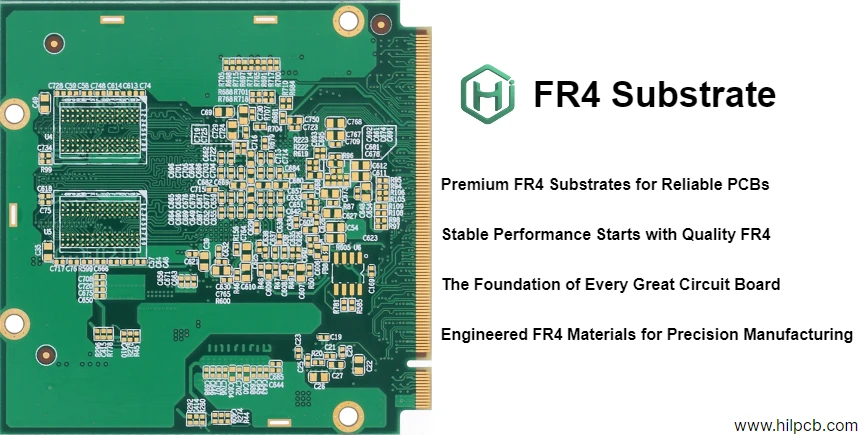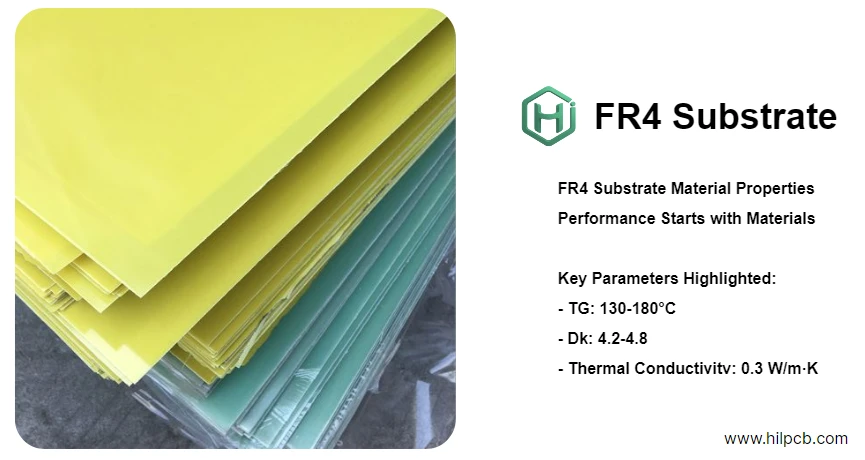Your FR4 substrate choice affects everything from signal integrity to product lifespan, yet many engineers treat it as an afterthought. They focus on circuit design and component selection while overlooking the foundation that makes it all work — the FR4 material itself.
Here's the reality: Two boards with identical circuit designs can perform drastically differently based on FR4 substrate properties. One maintains clean signals at high frequencies while the other suffers noise and distortion. One withstands years of thermal cycling while the other delaminates after months.
At HILPCB Factory, we've seen how substrate material properties make or break product reliability. This guide explains the critical FR4 characteristics that affect performance and how to specify them correctly for your application.
Understanding FR4 Substrate Composition
FR4 isn't a single material but a composite laminate combining several components, each affecting performance differently.
Core Components
Epoxy Resin System: The matrix that binds everything together. Different epoxy formulations provide different properties:
- Standard epoxy: Cost-effective, suitable for most applications
- Modified epoxy: Enhanced thermal or electrical properties
- Halogen-free epoxy: Environmental compliance without performance compromise
Glass Fabric: Woven fiberglass provides mechanical strength and dimensional stability. Fabric style affects:
- Mechanical rigidity
- Dielectric constant uniformity
- Drill quality and via reliability
Copper Foil: While technically not part of the substrate, copper type affects performance:
- ED (Electrodeposited) copper: Standard, economical
- RTF (Reverse-Treated Foil): Better adhesion for thin dielectrics
- VLP (Very Low Profile): Smooth surface for high-frequency designs
The specific combination of these components determines how your FR4 substrate performs across different parameters.
Material Property Specifications
When evaluating FR4 substrates for PCB manufacturing, these specifications matter:
**TG (Glass Transition Temperature):**The temperature at which FR4 transitions from rigid to rubbery state. Critical for thermal reliability.
**TD (Decomposition Temperature):**Temperature at which material begins breaking down. Typically 30-50°C above TG.
**CTE (Coefficient of Thermal Expansion):**How much the material expands with temperature. Lower CTE reduces stress on vias and component joints.
**Dk (Dielectric Constant):**Affects signal propagation speed and impedance. Lower Dk generally better for high-speed designs.
**Df (Dissipation Factor):**Measures dielectric loss — energy absorbed by substrate at high frequencies. Lower Df means less signal loss.

How FR4 Substrate Properties Affect Performance
The performance of a PCB is closely tied to the electrical and mechanical behavior of its FR4 substrate. For high-speed or RF designs, dielectric constant (Dk) and loss factor (Df) directly affect signal quality. Standard FR4 (Dk≈4.5, Df≈0.02) performs well up to about 2 GHz, but beyond that, variations cause impedance drift and timing skew. Using low-loss FR4 (Dk tolerance ±2 %, Df < 0.012) ensures stable impedance and lower attenuation up to 10 GHz or more—ideal for HDI PCB and high-frequency layouts.
Thermal stability defines long-term reliability. Standard FR4’s limited thermal conductivity (~0.3 W/m·K) and higher expansion rate (CTE 50–70 ppm/°C) can stress vias and solder joints during reflow or operation. High-Tg FR4 (170–180 °C) materials provide lower expansion and better mechanical strength, essential for lead-free assembly and power or multilayer designs. For heat-intensive builds, multilayer PCB configurations with copper planes and thermal vias further improve heat spreading.
Environmental durability also matters. FR4 can absorb moisture, raising Dk, lowering insulation, and risking delamination. Using low-absorption or halogen-free FR4, combined with dry storage and pre-bake practices, maintains stability. All HILPCB materials carry UL 94 V-0 flame ratings and comply with IPC-4101, RoHS, and REACH, ensuring both performance and regulatory confidence across global markets.
HILPCB’s FR4 Material Stock — Always Ready for Your Build
If you just need to know whether we have FR4 materials in stock, the answer is yes — we maintain a large, rotating inventory that covers all standard and advanced PCB builds. Below are some examples of our regular stocked materials; for precise and up-to-date availability, please contact us directly.
1. Standard FR4 Materials (for General Electronics)
- Shengyi S1000-2M / S1000H – Tg 135–140 °C, perfect for everyday consumer and industrial boards
- Nanya NP-155F / NP-140G – Mid-Tg laminates with reliable lead-free compatibility
- Ventec VT-47 / VT-42 – Cost-efficient options for prototypes and small-batch assembly
- Isola FR406 – Stable dielectric and excellent registration for 4- to 10-layer designs
These standard FR4 grades are always on hand for 1-oz copper, 1.6 mm boards — the fastest path from quote to shipment.
2. High-Tg and Enhanced FR4 (for Harsh Environments)
- Shengyi S1170 / S1180, Nanya NP-180T, Isola 370HR — 170–180 °C Tg range for automotive, power, and industrial control
- Ventec VT-481 – Halogen-free, high-Tg laminate meeting RoHS and UL 94 V-0
- High-Thermal FR4 – Optimized resin systems for repeated reflow and heavy-copper applications
Commonly reserved for automotive, power, or multi-reflow projects. Stock replenished weekly — inquire early to secure panel lots.
3. Specialized & Low-Loss FR4 Options
- Low-loss FR4 (Df ≤ 0.012) for high-speed digital, RF, and controlled-impedance multilayer PCB designs
- Halogen-free FR4 for eco-compliant and export-regulated builds
- Hybrid FR4 + PTFE stack-ups for mixed-signal and antenna modules
- High-thermal-conductivity FR4 used in LED drivers and power converters
- CTE-balanced laminates to minimize warpage in asymmetric or heavy-copper designs
Most low-loss and halogen-free variants are stocked in 1.0 mm and 1.6 mm cores; other thicknesses available on request.
4. Quick Stock Check & Reservation
Because FR4 materials move fast, we suggest confirming your lot before placing the build. Send your Gerber files + target thickness + copper weight, and our engineers will:
- Confirm current stock lots (brand, Tg, batch number)
- Provide material COC and UL file reference
- Hold inventory under your project name
- Suggest equivalent substitutes if your preferred code is out of stock
Frequently Asked Questions
How does FR4 substrate differ from other PCB materials like Rogers or polyimide?
FR4 offers the best cost-performance balance for frequencies below 5 GHz and operating temperatures below 150°C. Rogers materials provide better high-frequency performance but cost 5-10x more. Polyimide offers higher temperature capability (up to 260°C continuous) but is more expensive and brittle than FR4.
Can I mix different FR4 grades in a multilayer board?
While technically possible, we don't recommend it due to CTE mismatch between materials causing lamination stress and potential delamination. For special applications requiring different properties on different layers, we can design appropriate stackups, but single-material construction is more reliable.
What's the shelf life of FR4 substrate material?
Properly stored copper-clad laminates remain usable for 12+ months. Finished PCBs with ENIG or OSP surface finish should be used within 12 months for optimal solderability. We date-code all materials and provide storage recommendations with every order.
How do I specify FR4 substrate requirements in my design files?
Include these specifications: TG rating, copper weight, board thickness, any special requirements (halogen-free, impedance control, etc.). Our engineering team reviews all specifications during DFM analysis and recommends alternatives if more appropriate materials are available.
Does FR4 substrate quality affect assembly yield?
Absolutely. Poor-quality FR4 with excessive warpage causes placement accuracy issues. Inadequate copper adhesion leads to trace lifting during soldering. Low TG material may delaminate during reflow. We use only premium-grade FR4 from certified suppliers to ensure consistent assembly results.

